Elephants captured and brought to the Kraal became prisoners of man and were condemned to a cruel life of servitude
When an elephant made the British Governor General run for his life and shook the conscience of a nation
By C.S.Rohana Nanayakkara
That single Rifle shot, fired on August 10, 1950 reverberated around the world and tugged at the warm heartstrings of a grieving nation for a fallen indomitable warrior. For the local national newspapers it was front page headline news screaming “Preferred Death to Captivity” under a photograph of the warrior at the very moment of death, defiant and fighting to the end. In England, the national newspapers carried it in prominent details, while the “Daily Graphic” of London, carried it prominently with a photograph of Lord Soulbury, Governor General of Ceylon headlining the news of “his Run for Dear Life” in detail. The killing of the warrior for freedom was debated in Parliaments, analysed in knowledgeable circles, emotionally in street corners and tea kiosks, in the market places and in hushed, mournful tones in the homes of the people. “Kavi Kola Karayas” roamed the streets selling their printed poetic laments for a few cents. The “Rediffusion” sets in every tea boutique and eatery blared forth songs of the Bravery of the Dead Monarch. Several months, earlier, the proceedings had commenced to conduct an “Elephant Kraal” in the “nindagam” lands of the Maduwanwela clan at Panamure in Kolonne Korale, by Sir Francis Molamure, Speaker of the Parliament of Ceylon, who held these lands in trust for the last in line of his relatives, a crippled female called “Dingiri Appay” also “Kera Manike”. More than 1800 persons had toiled to build a stout stockade of jungle trees and cross beams bound with strong jungle vines and ropes, enclosing a perennial fountain or “Bubula” where the elephants came for water in the dry months of July and August.
- The killing of the warrior for freedom was debated in Parliaments, analysed in knowledgeable circles, emotionally in street corners and tea kiosks, in the market places and in hushed, mournful tones in the homes of the people
- Once the “drive in” was effected, then began the “sport” of capture and tying of the animals to the trees by their hind legs, within the Kraal. It was then, perhaps, that realisation dawned that they were now prisoners of man and were condemned to a cruel life of servitude, far away from the freedom of their beloved jungles
 |
| This is how the Ceylon Daily News report on the killing of “Panamure Ath Raja” |
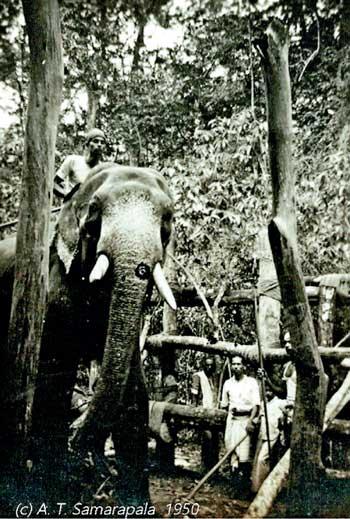 |
| The legacy of that Brave Bull Elephant brought about much debate in the country and the Parliament |
Galleries for the VVIPs
The mineral content of this water was a further attraction to these jungle giants. Overnight a small town sprang up, with a Police Post, Post Office with Telegraph, Medical post, shops, markets and huts for the workers, as well as elevated viewing galleries for the VVIPs and other distinguished invitees, for this was called a “Sport”, staged for their titillation, also as a display of power, influence and affluence of the Organisers, as well as to enhance their own wealth by the proceeds of the auctions. These preparations completed, scouts were sent out to scour the jungles for a suitable herd, located and driven relentlessly by noise and fire to the Kraal and the gates closed. The herd, 17 in number, consisting of Adults, sub adult males and females, as well as several small babies still suckling. Once the “drive in” was effected, then began the “sport” of capture and tying of the animals to the trees by their hind legs, within the Kraal. It was then, perhaps, that realisation dawned that they were now prisoners of man and were condemned to a cruel life of servitude, far away from the freedom of their beloved jungles. The attempt to capture and tie the matriarch precipitated the rebellion against captivity, when the leader, a huge young bull, made ferocious charges at those who entered the Kraal, immediately halting all capture operations. Several attempts to enter and resume operations met with continuous ferocious challenges of this young bull and had to be suspended. Finally it was decided to send in the domesticated bulls with their mahouts in an attempt to control this bull. Led by the great “Mampitiye Tusker” they entered the stockade. At the angry “no holds Barred” charge of this bull, the MampitiyaTusker turned tail and fled in fear, only to be chased and gored on his hind quarters with tushes of the Panamure elephant. Another elephant, too refused to meet this “Panamure Bull” and only the elephant “Gunaya” was left to face this unrelenting warrior. Eyewitness accounts record that the two met head on, but such was the great strength of the wild one, the impact made him go sideways, whereupon the wild one charged him on the shoulder. Gunaya was knocked to the ground, while the wild one got on his body and started attacking Gunaya with his tushes and it was with great difficulty and risk that Gunaya was rescued. It is said that the Organiser decided to release this wild bull and chase him away to the jungles, so that normal operations could continue. But on opening the gate of the Kraal the wild bull went out in the direction of freedom, but suddenly turned and rushed back into the stockade to join the herd, a hall mark of a true leader, not willing to abandon his herd for his own freedom.
Cautioned by Dr. R.L. Spittel
By this time, several of the captives had been tethered to trees and their antics to free themselves were most pathetic. Dr. R. L. Spittel, who was present, cautioned the organisers of these undue stress and unimaginable contortions of the captives will permanently damage their health and affect their suitability for domesticated work, so to quickly proceed with care and caution. Lord Soulbury, the Governor General of Ceylon, expressed a wish to enter the Kraal and inspect the captives and was assured by Molamure, that his “Charmed Walking stick of rare Madara wood” will ensure their safety. So the Governor General of Ceylon and the Speaker of the Parliament walked in to the stockade, not knowing that the wild bull had not read the book on “Charmed Walking Sticks of Madara wood”, charging them on sight with no uncertain evil intent, which immediately precipitated a headlong flight of the two dignitaries in most undignified manner; Lord Soulbury gaining the side of the stockade and creeping through the cross beams to safety by the veritable “skin of his teeth”, while the Speaker was saved by a fall into a deep ditch, into which the bull had no inclination to descend. Fortunately both personages escaped with minor scrapes, other than for an undignified exit.
After this incident, a decision was made to tie down the wild bull using a one inch thick wire rope, which would have cut the flesh to the bone, once in place, considering the violent struggles made for freedom. Two such ropes were broken off by this Bull, and the third attempt was even worse, the incorrectly placed wire rope getting wedged between the nails of one foot, further maddening the animal. With the Organisers at a loss as to what to do next, the Police Inspector was called by Molamure and ordered to kill the bull with one shot. It is debatable if it was the inadequacy of the .303 weapon or some other factor, that prompted the Inspector, but he refused, and was summarily dismissed. Into this scenario came Sam J.C. Kadirgamar, travelling on his jungle trips with two friends. Kadirgamar, was one of the best shots in Ceylon at the time, was found to be equipped with several weapons, one of which was a .375 Magnum rifle, recently imported from Britain, from a highly reputed maker of Rifles and a highly suitable fire arm for large animals.
Kadirgamar
Molamure sought the help of Kadirgamar for the shot, well knowing his prowess in shooting. Apparently it was agreed to with reluctance by the shooter. Interestingly, almost exactly 30 years later, in late July 1980, sitting in the verandah of the Senior Navy Officers Holiday bungalow “Forest Side” in Trincomalee, he quite suddenly, brought out this subject of the Panamure elephant, recounting the events to me. Even after 30 years, the sadness and remorse of the event were evident in his voice, which implied that he was a reluctant participant. Said he “When I walked into that Kraal with my rifle, that elephant knew he was going to die. He turned away from me, going to each of the captives, throwing dust and branches on them, as if in a last act of farewell, then he turned around and charged me at speed , Trunk curled up, ears flapping, its eyes lit up with fire of Defiance, Death and Destruction”. Eye witness accounts say that Kadirgamar kneeled and at around 20 yards, fired. At the shot the wild bulls rear legs buckled, then the front legs and he rolled over and fell to his left. The high powered bullet had gone through to the centre of its head and perhaps death was instantaneous. The relentless battle for freedom for his herd was over. It is said that with the fall of the monarch, a hush fell on the gathering of several thousand people there, some cried, some cursed the organisers, some were stunned in to disbelief, while some of the special invitees, who had access to the inside of the Kraal, quickly descended on the carcass, posing for jubilant photographs with the carcass.
Within a very short time all the tail hair had been removed for amulets and souvenirs, while Kadirgamar had left the scene early without any souvenir. In addition to the bullet wound two deep wounds made by Goads were on the head, also the wire rope cutting into its fore foot between the nails. Soon the tying of the rest was completed and a day later, auctioned off by the Chairman of the Madampe Cooperative Society. The plight of the babies was most pathetic, one who had been separated from its mother, was most moving and newspapers reported that a young invitee maiden had been pleading to her mother to buy the baby elephant at the auction for “her Dowry”. The legacy of that Brave Bull Elephant brought about much debate in the country and the Parliament, mostly against the event and the Killing of the King. People were free with their curses and out on the streets, more exacerbated by the arrogant attitude of the Speaker during Parliamentary Debate, saying “what I do in my back yard is nobody’s business”. The upshot of these episodes was that Elephant Kraaling was completely banned in Ceylon, so this young Monarch, cremated where he fell, did not die in vain for his kind.
The common man is of the opinion that elephants are guarded by the Deities, especially the tuskers, though this bull was not a Tusker, the wrath of the deities will surely come. Be that as it may, the Speaker, Sir Francis Molamure, organiser of the Kraal, collapsed in the Speaker’s Chair in Parliament and was dead on arrival at the Hospital; barely six months later in January 1951. Sacrificing his life for the Freedom of his herd, this Courageous “Panamure Ath Raja” struck a telling blow to the Conservation of all Wild Life, with deeds, action and unvoiced words, 75 years ago, today. The nation and the world heard it then, but have we forgotten?
(Based on Pers comm, with participants and contemporary eyewitness accounts in Ceylon and British publications)
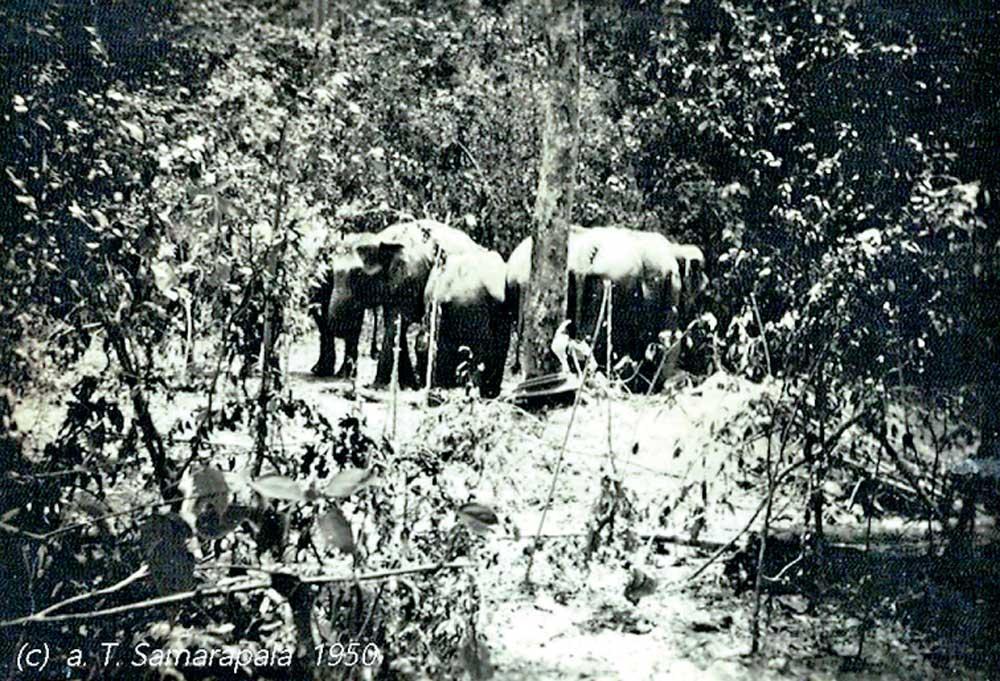
Captives are seen tethered to trees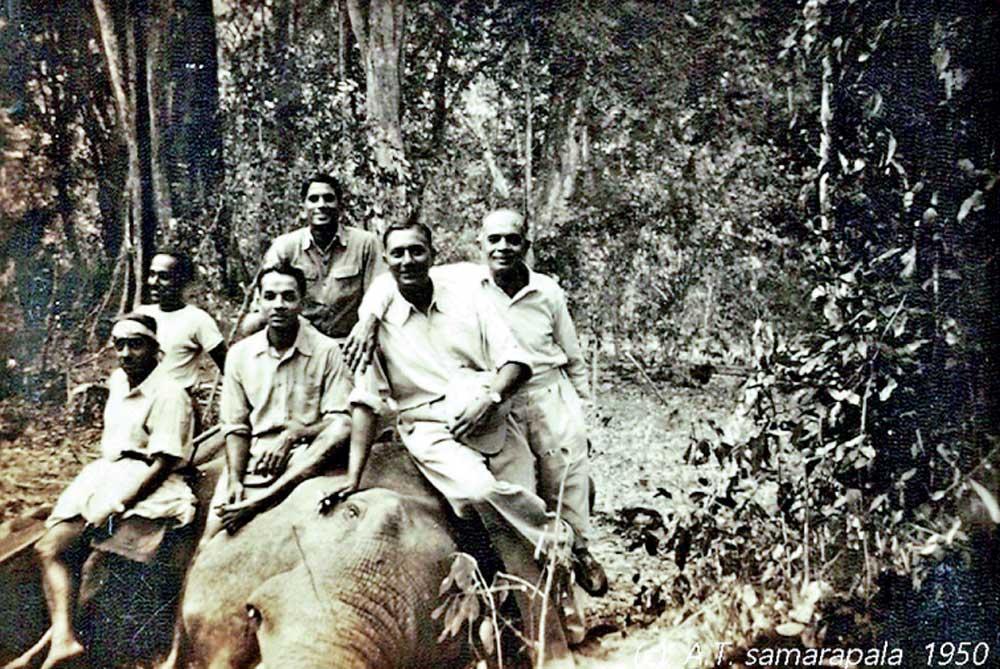
It’s said that some special invitees, who had access to the inside of the Kraal, quickly descended on the carcass, posing for jubilant photographs 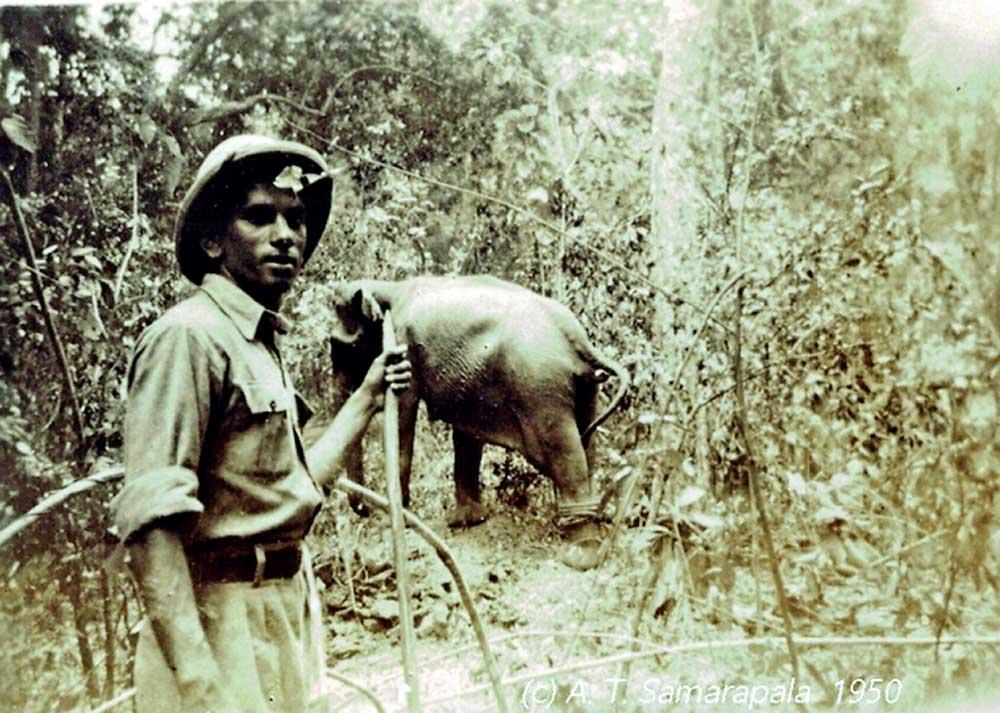
The common man is of the opinion that elephants are guarded by Deities and those who kill them will received the wrath of the deities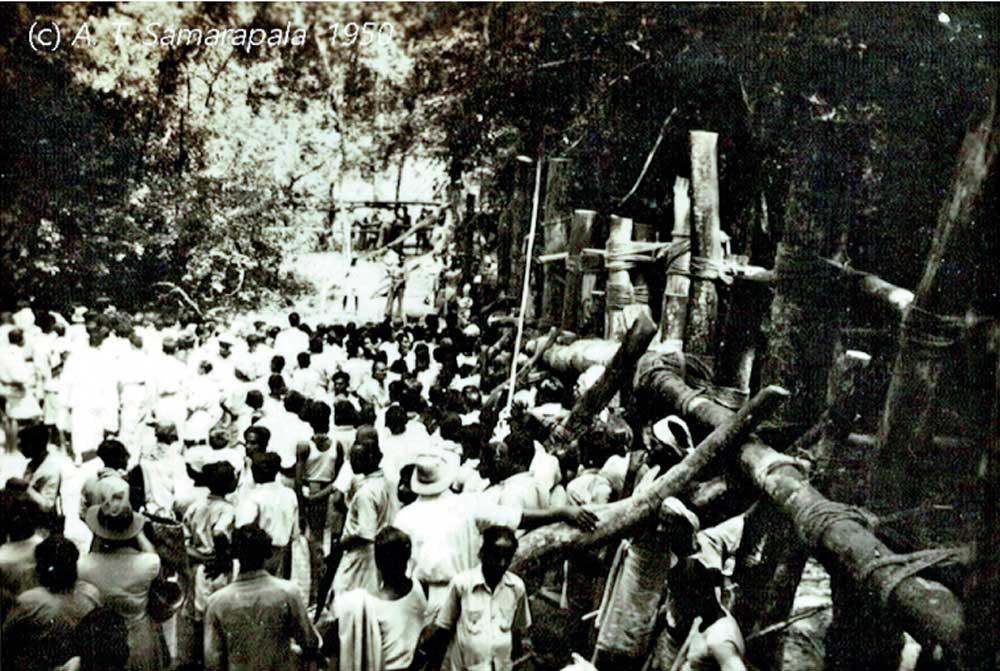
Kraals were built to tame bulls and entertain gatherings of people who came to witness the rich man’s sport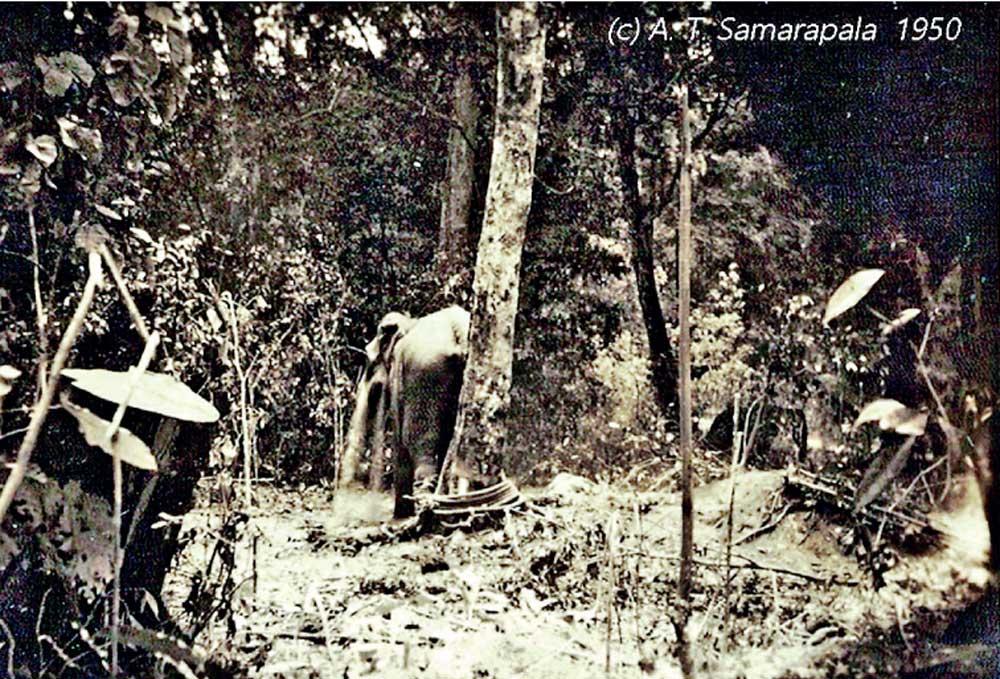
An elephant in captivity

